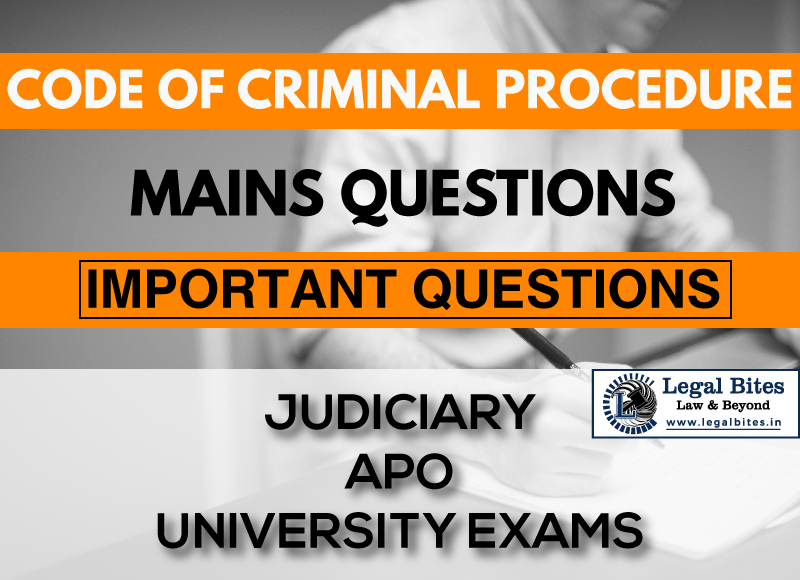What is plea bargaining? Briefly describe its procedure and whether these provisions apply with respect to all types of offences and all types of victims.
Find the answer to the mains question only on Legal Bites.;

Question: What is plea bargaining? Briefly describe its procedure and whether these provisions apply with respect to all types of offences and all types of victims. [UPCJ, 2013, 2016, 2023, JJS 2018] Find the answer only on Legal Bites. [What is plea bargaining? Briefly describe its procedure and whether these provisions apply with respect to all types of offences and all types of victims.] Answer In Indian Criminal Justice System, Plea Bargaining is applicable in respect of those...
Question: What is plea bargaining? Briefly describe its procedure and whether these provisions apply with respect to all types of offences and all types of victims. [UPCJ, 2013, 2016, 2023, JJS 2018]
Find the answer only on Legal Bites. [What is plea bargaining? Briefly describe its procedure and whether these provisions apply with respect to all types of offences and all types of victims.]
Answer
In Indian Criminal Justice System, Plea Bargaining is applicable in respect of those offences for which punishment is up to a period of 7 years. Moreover, it does not apply to cases where the offence is a Socio-Economic offence or where the offence is committed against a woman or a child below the age of 14. Also, once the court passes an order in the case of Plea Bargaining, no appeal shall lie to any court against that order.
The plea means to bring forward one’s excuse, justification, defence, and bargaining to arrive at an agreement of favourable purchase. A “plea bargain” is a practice whereby the accused forgoes his right to plead not guilty and demand a full trial and instead uses a right to negotiate for a benefit.
In other words, plea bargaining means the accused’s plea of guilty has been bargained for, and some consideration has been received for it. Plea Bargaining is an arrangement between the prosecutor and defendant whereby the defendant pleads guilty to a lesser charge in exchange for a more lenient sentence or an arrangement to drop other charges.
Salient Features of Plea Bargaining
- It is applicable in respect of those offences for which punishment is up to a period of 7 years.
- It does not apply to cases where the offence is committed against a woman or a child below the age of 14 years.
- When a court passes an order in the case of plea bargaining, no appeal shall lie to any court against that order.
- It reduces the charge.
- It drops multiple counts and presses only one charge.
- It makes a recommendation to the courts about punishment or sentence.
Sections 265A to 265L are incorporated in the Code of Criminal Procedure (CrPC) by Amendment Act with effect from the 5th of July, 2006, to give effect to the “Plea Bargaining” system. The provisions can be summarized briefly as follows:
- The accused is entitled to avail the benefit of “plea bargaining” both in the cases instituted on the police report as well as by way of a private complaint under Section 200 CrPC.
- The benefit of “plea bargaining” is available to the accused that is not guilty of committing an offence punishable by death or life sentence and not exceeding seven The benefit also does not apply if the crime affects the socio-economic conditions of the society and also to the crimes committed against woman or child below the age of 14 years. Plea bargaining is not applicable to juvenile offenders.
- The accused should make an application. The court should conduct in camera inquiry to ascertain that the application is voluntary and without duress. The Court should notify the public prosecutor and the victim to arrive at a final disposition.
- On the admission of guilt, the Court should impose One-Fourth of the sentence prescribed for the offence. In case the offence is punishable by minimum imprisonment, half of such imprisonment is to be imposed. In both situations, the Court can award compensation to the victim after productive negotiations with the accused and the victim.
- The accused is entitled to the benefit of the Probation of Offenders Act, the benefit of let off under section 428 CrPC and the benefit of bail.
- The accused convicted in the system of a plea of bargaining has no right of appeal, but the remedy of writ jurisdiction under Articles 226 and 227 and Special Leave Petition under Article 136(9) of the Constitution of India is not barred.
Important Mains/Long Questions for Judiciary, APO & University Exams
- CRPC Mains Questions Series Part I: Important Questions
- CRPC Mains Questions Series Part II: Important Questions
- CRPC Mains Questions Series Part III: Important Questions
- CRPC Mains Questions Series Part IV: Important Questions
- CRPC Mains Questions Series Part V: Important Questions
- CRPC Mains Questions Series Part VI: Important Questions
- CRPC Mains Questions Series Part VII: Important Questions
- CRPC Mains Questions Series Part VIII: Important Questions
- CRPC Mains Questions Series Part IX: Important Questions
- CRPC Mains Questions Series Part X: Important Questions
- CRPC Mains Questions Series Part XI: Important Questions


